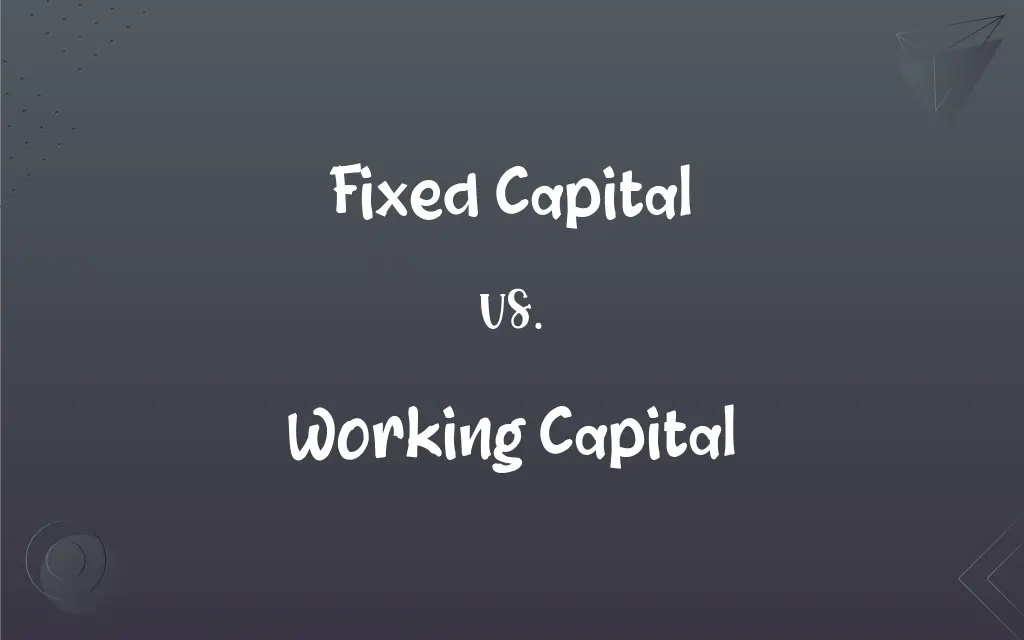Fixed Capital vs. Working Capital: What's the Difference?
Edited by Janet White || By Harlon Moss || Updated on October 26, 2023
Fixed capital refers to long-term assets used in production, while working capital is the difference between a company's current assets and liabilities.

Key Differences
Fixed capital pertains to the long-term assets a business invests in to produce goods or services. These assets, like machinery, buildings, and land, are not easily converted into cash. In contrast, working capital refers to the short-term assets and liabilities that facilitate the daily operations of a company.
In the realm of business finance, fixed capital plays a crucial role in the production process. These assets, once acquired, remain with the business for a prolonged period, assisting in generating revenue. On the other hand, working capital ensures that a company can meet its short-term financial obligations and can fund its immediate operational needs.
The investment in fixed capital generally requires significant amounts of money and is not intended for sale within the business cycle. It forms the backbone of a company's production capabilities. Working capital, conversely, fluctuates over time, adjusting based on the current assets (like inventory or accounts receivable) and current liabilities (like short-term debt or accounts payable).
Adequate fixed capital is essential for businesses to maintain and upgrade their production capacity and to stay competitive in the market. Without it, a company might struggle to scale or innovate. Equally, sufficient working capital is vital for the smooth running of daily operations, allowing businesses to cover immediate expenses and handle short-term debts.
Both fixed capital and working capital are indispensable for a company's financial health. While fixed capital supports long-term growth and production, working capital helps in navigating daily financial challenges, ensuring that the business remains solvent and can seize new opportunities.
ADVERTISEMENT
Comparison Chart
Nature
Long-term assets
Difference between current assets and current liabilities
Liquidity
Not easily converted into cash
More liquid and fluctuates daily
Purpose
For production and long-term growth
For daily operations and short-term financial needs
Examples
Machinery, buildings, land
Inventory, accounts receivable, short-term debts
Duration
Remains with the company for extended periods
Changes regularly based on short-term financial transactions
ADVERTISEMENT
Fixed Capital and Working Capital Definitions
Fixed Capital
Fixed capital assets are not meant for resale within a business cycle.
Land and buildings, key components of our fixed capital, aren't sold frequently.
Working Capital
Working capital fluctuates based on short-term financial transactions.
Seasonal sales surges can temporarily increase our working capital.
Fixed Capital
Fixed capital refers to assets with long-term use in business.
The factory machinery, part of the company's fixed capital, was purchased five years ago.
Working Capital
Working capital supports daily operational expenses and immediate financial needs.
We utilize our working capital to pay monthly salaries and utility bills.
Fixed Capital
Fixed capital encompasses investments in non-current assets vital for production.
Investing in a new facility will increase our fixed capital, enhancing production capacity.
Working Capital
Working capital ensures a company's short-term financial solvency.
With enough working capital, the company can handle unexpected costs.
Fixed Capital
Fixed capital is essential for maintaining and growing a company's production capabilities.
Our consistent growth is due to regular reinvestment in fixed capital.
Working Capital
Working capital is crucial for seizing new business opportunities.
Our strong working capital allowed us to quickly invest in a trending product.
Fixed Capital
Fixed capital investments typically require significant funds.
The company is raising funds to boost its fixed capital through new equipment purchases.
Working Capital
Working capital is the difference between current assets and current liabilities.
A positive working capital indicates the company can cover its short-term obligations.
FAQs
What are examples of fixed capital assets?
Fixed capital assets include machinery, buildings, and land.
How is working capital calculated?
Working capital is the difference between current assets and current liabilities.
Can a business operate with negative working capital?
While possible, negative working capital may indicate liquidity problems.
Are patents and trademarks part of fixed capital?
They're long-term assets but are typically considered intangible, separate from traditional fixed capital.
What challenges can arise from inadequate fixed capital?
Limited production capacity, inability to innovate, and reduced competitiveness.
What happens if a company has insufficient working capital?
It might struggle to meet short-term obligations or seize opportunities.
Are vehicles considered fixed capital?
Yes, if used for business operations and not for resale.
What role does working capital play in a startup?
It supports daily operations and helps navigate initial financial challenges.
How can businesses improve their working capital?
By managing inventory, collecting receivables promptly, and negotiating longer payment terms.
Is cash considered part of working capital?
Yes, cash is a component of current assets in working capital.
Why is fixed capital significant for economic growth?
It enables businesses to produce more, leading to increased economic activity.
How do creditors view a company's working capital?
It's an indicator of short-term financial health and the ability to repay debts.
Can a business borrow to fund working capital needs?
Yes, short-term loans or lines of credit can boost working capital.
Are investments in technology considered fixed capital?
Yes, if they have long-term utility for the business.
How does seasonality impact working capital?
Businesses may need more working capital during peak seasons to fund increased operations.
Can depreciation affect fixed capital?
Yes, fixed assets like machinery depreciate over time, reducing their value.
Can inventory levels influence working capital?
Absolutely, excessive inventory can tie up funds, affecting working capital.
Is fixed capital a one-time investment?
No, businesses might reinvest in fixed capital to upgrade or expand.
Why is fixed capital essential for manufacturing businesses?
It supports production capacity, ensuring they can meet demand.
Do intangible assets count as fixed capital?
Generally, fixed capital focuses on tangible assets, but intangibles can be long-term investments.
About Author
Written by
Harlon MossHarlon is a seasoned quality moderator and accomplished content writer for Difference Wiki. An alumnus of the prestigious University of California, he earned his degree in Computer Science. Leveraging his academic background, Harlon brings a meticulous and informed perspective to his work, ensuring content accuracy and excellence.
Edited by
Janet WhiteJanet White has been an esteemed writer and blogger for Difference Wiki. Holding a Master's degree in Science and Medical Journalism from the prestigious Boston University, she has consistently demonstrated her expertise and passion for her field. When she's not immersed in her work, Janet relishes her time exercising, delving into a good book, and cherishing moments with friends and family.































































